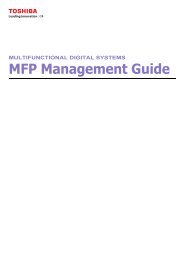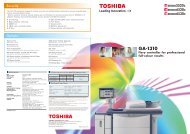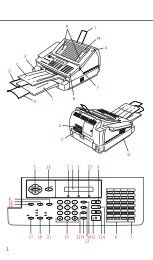11-12 GA-1120 Color Management - Toshiba
11-12 GA-1120 Color Management - Toshiba
11-12 GA-1120 Color Management - Toshiba
Create successful ePaper yourself
Turn your PDF publications into a flip-book with our unique Google optimized e-Paper software.
1-8 <strong>GA</strong>-<strong>11</strong>20 <strong>Color</strong> <strong>Management</strong><br />
If you are printing with the PostScript driver from a Windows computer and have<br />
two-way communication enabled, the name of each downloaded profile is represented<br />
in the RGB Source Profile setting pop-up menu. If you are printing with the AdobePS<br />
driver from a Mac OS computer, downloaded profiles appear as Source-1 through<br />
Source-10. For more information on two-way communication, see the User Software<br />
Installation Guide.<br />
• None instructs the <strong>GA</strong>-<strong>11</strong>20 to allow the RGB sources you defined elsewhere, such<br />
as in the application, to be used. When you set RGB Source to None, the<br />
appearance of colors will not be independent of the file type. For example, RGB EPS<br />
files will look different from RGB TIFF files.<br />
With RGB Source set to None, PostScript RGB data that contains a source color<br />
space definition is converted using the CRD specified by the Rendering Style option<br />
(see page 1-5). Non-PostScript RGB data and PostScript RGB data that does not<br />
contain a source color space definition are converted using a general undercolor<br />
removal (UCR) conversion method.<br />
RGB Separation<br />
The RGB Separation option determines how RGB colors (as well as Lab and XYZ<br />
colors) are converted to CMYK. The name of this option is meant to be descriptive,<br />
since the option defines the color spaces that will be used by the <strong>GA</strong>-<strong>11</strong>20 to “separate”<br />
the RGB data into CMYK values.<br />
The two choices available for this option determine whether RGB data is converted<br />
into the full gamut of the copier (output) or is first converted into the gamut of<br />
another digital printer or press standard (simulation). This feature is helpful for<br />
making one device behave like another for RGB data. For example, if a high-quality<br />
ICC profile is available for another print device, the copier can simulate the behavior<br />
of that device.<br />
RGB Separation is also useful for prepress applications. For example, it lets you<br />
experiment with the appearance of an RGB scan under different press printing<br />
conditions, without having to convert the RGB data to CMYK data for each<br />
condition. When the desired printing condition is found, you can then convert the<br />
file to CMYK, using the same CMYK simulation profile you used during the<br />
experimentation.






